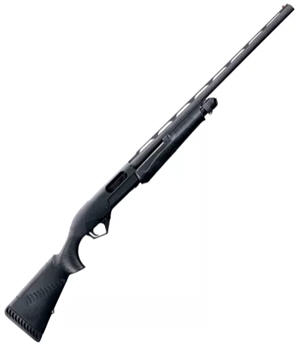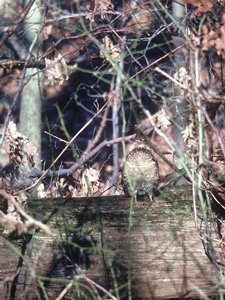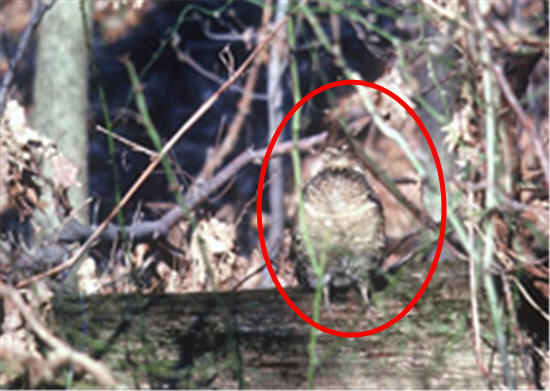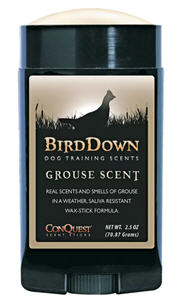
The ruffed grouse is without question one of the most challenging upland gamebirds to hunt. But one way you can improve your luck with this handsome brown and russet speedster is to avoid making mistakes.
I feel uniquely qualified to write a piece on this topic, since over the years I believe I have made every mistake possible in the grouse woods, some of them many times over. But gradually I began to learn from those mistakes. And as I did, I saw both my flushing and harvest rates go up and also my enjoyment of the sport. Sure, just walking through grouse country is fun. But bagging a few now and then certainly makes the experience a bit more rewarding!
It would be easy to list literally dozens of mistakes I've made or seen other grouse hunters make over the years. But we'll focus on the ones that are most common and the ones that hurt your chances for success the most. Knowing what they are ahead of time should help you avoid them, or at least recognize when you make them and avoid them the next time.
1. Not Getting in Hunting Shape
Grouse hunting is extremely demanding physically. You'll walk for hours, often in uneven, hilly or mountainous terrain. First get a physical, and then start an exercise program that is hunter specific before you get serious about grouse hunting. You might walk 5-10 miles in a day carrying a 6-7 pound firearm. Be ready for the challenge before you take it.
2. Using the Wrong Gun

Many grouse hunters use guns that are way too heavy. They also carry guns with barrels too long.
A heavy gun becomes a burden to carry on the long hikes through hilly or mountainous country grouse inhabit. It also is harder to bring up quickly and swing on a fast-departing target when you only have a second or two to find the bird and fire. The long barrel is a hindrance working through the thick, vine-tangled, briar-infested cover where grouse like to hang out. It can even get caught on sapling branches when you try to mount and fire.
Leave those guns at home and save them for waterfowl or pheasant hunts. Instead, tote a 12-28 gauge shotgun in any action you please, but make sure it's light. It should also have a fairly short barrel, for easy, quick swinging in thick cover. I like a double, but autoloaders and pumps are also fine. Avoid a single shot if possible, because you'll often miss with your first shot and occasionally the grouse will still be in view for a second try.
3. Using the Wrong Choke
Using the wrong choke tube is a common mistake for many kinds of upland bird and small game hunting, but it's especially critical for grouse. The thick cover these birds inhabit most of the time means shots will be short range. Sometimes they might be as close as 10-15 yards. Other times maybe out to 20-30 yards. Thirty-five yards would be a very long grouse shot.

camouflaged. Can you spot this one?
Check grouse image below to see if
you did.
That makes it clear that an open choke tube is usually the best bet. At times improved cylinder will be okay. But very rarely will a modified be a good choice. My main grouse gun is a 16-gauge bored skeet and skeet. If a bird gets up 35 or 40 yards away, I just pass it up. But 90 percent of them get up closer, and the open barrel gives a broad pattern that helps my mediocre shooting skills.
4. Using the Wrong Pellet Size
Small shot, size 7 1/2 or 8 is usually best for grouse. The smaller the pellets, the more in a shell and the more likely one or two will connect. And though they look big, grouse are fragile birds and fairly easy to bring down. I go with size 8 for early hunting, 7 1/2 for late season. If you're hunting unusually open terrain or it's late in the season and some grouse are flushing far out, 6's can also be a good choice. Anything bigger simply hurts your chances of connecting.
5. Walking Too Fast
Human nature makes us want to cover a lot of ground as we search for grouse. The more ground we cover, the more birds we'll find. Right? No. Not really.

log in this picture ?
Actually you'll probably walk past a lot of birds if you use that approach. You'll also wear yourself out faster physically and have to cut the length of the hunt short. Or you'll be tired when a bird flushes and not be able to mount and fire as quickly as you otherwise could. You'll also tend to rush past good bits of cover instead of walking them out thoroughly.
Grouse are extremely well camouflaged and really don't like to fly. They would much rather sit tight and let you saunter past them, even as close as ten feet away, rather than fly. They know they're exposing themselves to possible danger when they do and want to avoid it if possible. The slow walker seems more threatening to them and is more likely to make them flush.
6. Not Stopping Often Enough
This brings us to a related mistake. Not only should you walk slowly while hunting to be sure you cover the best habitat carefully, you should pause often. This is not just to keep your stamina up, but also a strategic tactic. Pausing seems to make a grouse feel a predator has spotted him and is about to attack. The silence unnerves him, compared to a hunter just casually walking past him. He tenses and flushes.
I've found that you'll flush almost twice as many birds by stopping frequently in good cover as you will if you simply walk through it. It also lets you raise the gun to port arms and be ready if a bird rockets out.
7. Not Stopping at the Right Locations
Make sure you're in a clear area when you stop so you can raise the gun and swing it without the barrel catching on a grape vine or sapling growth. Also stop near enough to the prime cover that when a bird flushes he won't be out of range. And finally try to chose a spot where there won't be an obstruction between you and the quarry when it flushes.
8. Hunting in the Wrong Type of Cover

There are generally two types of cover in a typical forest. One is open, park-like, with mature timber. It looks like a nice place to take a walk or have a picnic. Then there's grouse cover!
It's thick, congested, overgrown with grapevines, greenbrier and dense sapling growth. There are blowdowns, laurel, rhododendron, young aspen and alder trees. Sometimes the area is growing back from clear-cutting. It makes for tough walking and tough shooting. But that's where the grouse are.
The mistake too often made is hunting where it's easy walking, easy shooting and inviting. The grouse aren't there. They're in the thick stuff. Get in and bust them out.
9. Not Finding the Food
Not only do you need to find this thick grouse habitat, you can improve your chances further by pinpointing areas within these dense jungles that provide grouse the most food. It could be grapes, honeysuckle, ferns, greenbrier, oaks, or aspen. Dogwoods are also favored, as are hawthorn, alder, blackberry, raspberry, viburnum, plum, sumac, ash, birch, cranberry and olives. Old abandoned orchards can also attract the birds for the leftover fruit. Ridges are often best early. Later they may move down to hollows, stream bottoms and more protected cover with less snow accumulation.

will stay close, like this Irish Setter, so
they won't scare off the grouse.
10. Hunting Too Close to the Road
Birds will be warier and spookier here. They'll also be present in lower numbers because of the hunting pressure they've been exposed to. Hike in a quarter or half mile, and then start hunting. You'll find more birds and they'll be less skittish.
11. Using Wide-Ranging Bird Dogs
A dog can be a great help in grouse hunting. But if you have a wide-roaming hunting dog that doesn't stay close and obey commands well, it can actually bump more birds out of range than it points for you. By all means, bring a dog if he's trained to hunt close and knows grouse. Otherwise, you might do better off just jump shooting the birds. I like a dog that sticks close, always within about 50-75 yards or closer.

Grouse Scent
Tip: BirdDown Dog Training Scent lets you add the scent and smell of real grouse to your dog's training easily. Easy-to-apply and easy-to-use, this wax-based stick adds a strong scent of a grouse to a training dummy with a simple dab or wipe on the dummy.
12. Not Shooting Quickly Enough
This is common among novices in particular. A grouse thunders out of cover, often right at your feet, so loudly and raucously that it's shocking. By the time you collect yourself and raise the gun, he's out of sight. Or maybe he's so close you let him get a ways out so the shot won't damage the meat. In both cases, the clever grouse will likely put brush or a tree between you and him and vanish before you slap the trigger. Shoot quickly, as soon as you can get the gun up to your shoulder and firmly mounted and your cheek down on the stock.
13. Not Being Ready for a Second or Third Grouse to Flush
If you flush a grouse, there's often a chance another bird may be in the covert where he was. Be ready for a second chance if you missed the first bird. If you bagged the first grouse and have marked carefully in your mind exactly where it fell, then you can try for a second one. If you haven't, let the second grouse go and concentrate on locating the one you hit.
14. Not Watching Carefully Where a Flushed Bird Flies
If you miss a grouse, there's a decent chance you can re-flush it. But to do that you need to watch carefully as it flies away and get a good bead on where it might have landed. Often it will fly through a semi-open area, land and then run into the next thick patch of cover. Pay attention and you may get a second, or even a third crack at that bird.
15. Hunting in Areas Exposed to Strong Winds
Grouse don't like wind. It robs them of their ability to sense movement of brush and potential approaching predators. And in winter it robs them of body heat and chills them. Look for hollows, valleys, dips, and sides of hills protected from the strongest breezes to bag the most grouse. You'll also find the hunting more comfortable there as well.
16. Hunting Alone
If the truth be known, I have to confess I do this a lot. But when possible, always try to bring a buddy or two along. It's much easier to thoroughly hunt a patch of cover if two bodies are walking through it, trying to flush birds.
Often you'll move a grouse that will fly by your partner and vice versa. That will give you extra shooting opportunities you wouldn't otherwise have. Four eyes are also better than two for finding dead birds. And it's simply fun to share the woods with a companion and share the joys and frustrations of chasing America's most challenging upland game bird.
- 99822 views

